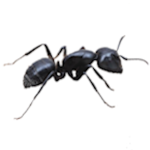Carpenter Ants
Camponotus

Carpenter ants are the most common pests we exterminate. Several species exist in North America.
Where do carpenter ants get their name?
Carpenter ants belong to the class of insects known as Hymenoptera, which also includes bees and wasps. Carpenter ants derive their name from the appearance of their nesting galleries, which are smooth, clean, and sculptured. Unlike termites, you will find no dirt, excrement, or sawdust in their nests.
What are their eating habits?
Although it may appear that they eat wood like termites, carpenter ants are not able to digest cellulose. Instead, they prefer to eat insects and decaying fruits. Should they decide to invade your home, they will feast on most anything you eat, including sugar-based products, butter, and even steak.
Where do they set up nests?
The important question regarding carpenter ants is: why do they invade homes? Some species of carpenter ants prefer the outdoors while other species are prone to infesting structures. If ants decide to nest outside, they will use places like hollow trees, rotten stumps, firewood piles, or soil beneath fallen timber. When they invade a house, they probably get there one of two ways or possibly both.
How does a structure become target for invasion?
A founding queen may start her colony in a building and the budding population may take several years to become a noticeable problem. The other primary means of structure occupation is when a mature colony takes up residence in a susceptible structure in a wooded area, which is usually adjacent to their existing nest.
What is the appearance of carpenter ants?
The appearance of carpenter ants varies. Some are small. Others are among the largest ants known. Workers tend to be 1/4″-3/4″ long. Winged ants, which are the reproductive males and females, are generally longer.
Why do you need to worry about carpenter ants?
So, why should you worry about carpenter ants? You may only spot a  few ants, but those ants come from a whole colony hard at work tunneling and creating nesting galleries just below the wood surfaces of your building. If the ants’ activity remains neglected, severe structural damage is a likely consequence. Early treatment will preclude having to pay expensive fees to restore the structural integrity of a building at a later date.
few ants, but those ants come from a whole colony hard at work tunneling and creating nesting galleries just below the wood surfaces of your building. If the ants’ activity remains neglected, severe structural damage is a likely consequence. Early treatment will preclude having to pay expensive fees to restore the structural integrity of a building at a later date.
